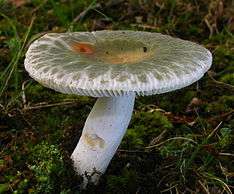Russula crustosa
| Russula crustosa | |
|---|---|
 | |
| Scientific classification | |
| Kingdom: | Fungi |
| Division: | Basidiomycota |
| Class: | Agaricomycetes |
| Order: | Russulales |
| Family: | Russulaceae |
| Genus: | Russula |
| Species: | R. crustosa |
| Binomial name | |
| Russula crustosa Peck (1886) | |
Russula crustosa, commonly known as the crusty russula, is a species of fungus in the family Russulaceae. It is found in Asia and North America.
Taxonomy
The species was first described scientifically by American mycologist Charles Horton Peck in 1886, who made the type collections in Day, New York.[1] It is classified in the subsection Virescentinae of the genus Russula.[2] The specific epithet crustosa means "with a rind".[3] Common names for the species include "crusty Russula",[4] "green quilt Russula", and "encrusted Russula".[5]
Description
The fruit bodies have caps that are initially convex before flattening out in age, often developing a central depression, and measure 5–12.5 cm (2.0–4.9 in) in diameter. In maturity, the dry cap surface breaks up into greenish patches around the margin. The margin of the cap has radial grooves that match the gills on the underside. The closely spaced gills are white, cream, or pale yellow in color, and have an adnate attachment to the stem. Measuring 3–9 cm (1.2–3.5 in) long by 1.2–2.5 cm (0.5–1.0 in) thick, the stem is white to pale yellow, and becomes hollow in age. The flesh is hard and compact (when young), and whitish. The spore print is pale buff, and the spores are elliptic in shape, and somewhat warted with a few fine interconnecting lines. They are hyaline (translucent), amyloid, and measure 6–9 by 5.5–7 µm.[4]
An edible mushroom, R. crustosa has no distinguishing odor, and a taste ranging from mild to slightly acrid. Other greenish Russulas, including R. subgraminicolor, R. aeruginea, and R. variata, can be most readily distinguishing by their non-cracking cap surfaces.[4]
Similar species
Russula crustosa is commonly mistaken for Russula virescens, a more desirable edible mushroom that features greenish patches on its cap surface. The latter species has flesh that breaks apart more readily, and a white spore print.[4]
Ecology and distribution
Russula crustosa is a mycorrhizal fungus and associated with broadleaf trees, particularly oak[4] and hickory.[3] The fruit bodies grow on the ground in mixed forests singly, scattered, or in groups. Fruiting occurs between June and December.[4] The pleasing fungus beetle species Tritoma angulata is known to feed on the fruit bodies.[6]
In North America, the mushroom is common, and widespread in the southeastern United States. In Asia, Russula crustosa is found in China,[7] India,[8] Malaysia,[9] and Thailand.[10]
See also
References
- ↑ Peck CH. (1886). "Report of the Botanist (1885)". Annual Report on the New York State Museum of Natural History. 39: 30–73 (see p. 41).
- ↑ Buyck B (2010-12-27). "Provisional key to subsection Virescentinae in the U.S.". Russulales News. Retrieved 2013-10-23.
- 1 2 Smith AH, Weber NS (1980). The Mushroom Hunter's Field Guide. Ann Arbor, Michigan: University of Michigan Press. pp. 267–8. ISBN 0-472-85610-3.
- 1 2 3 4 5 6 Bessette AE, Roody WC, Bessette AR (2007). Mushrooms of the Southeastern United States. Syracuse: Syracuse University Press. p. 192. ISBN 978-0815631125.
- ↑ Binion D. (2008). Macrofungi associated with oaks of Eastern North America. West Virginia: West Virginia University Press. p. 179. ISBN 978-1-933202-36-5.
- ↑ Goodrish MA, Skelley PE (1994). "Fungal host records for species of Tritoma (Coleoptera: Erotylidae) of America north of Mexico". Entomological News. 104–105: 289–94.
- ↑ Chen XH, Zhou HB, Qiu GZ (2009). "Analysis of several heavy metals in wild edible mushrooms from regions of China". Bulletin of Environmental Contamination and Toxicology. 83 (2): 280–5. doi:10.1007/s00128-009-9767-8.
- ↑ Bhatt RP, Lakhanpal TN (1988). "Russula crutosa Peck– an addition to Indian edible mushrooms". Current Science. 57 (10): 560–1. ISSN 0011-3891.
- ↑ Watling R, Lee SS, Turnbull E (2002). "The occurrence and distribution of putative ectomycorrhizal Basidiomycetes in a regenerating south-east Asian rainforest". In Watling R, Frankland JC, Ainsworth AM, Isaac S, Robinson CH. Tropical Mycology: Macromycetes. 1. CAB International. p. 30. ISBN 978-0-85199-793-3.
- ↑ Phosri C, Põlmi S, Taylor AF, Kõljalg U, Suwannasai N, Tedersoo L (2012). "Diversity and community composition of ectomycorrhizal fungi in a dry deciduous dipterocarp forest in Thailand". Biodiversity Conservation. 21 (9): 2287–98. doi:10.1007/s10531-012-0250-1.